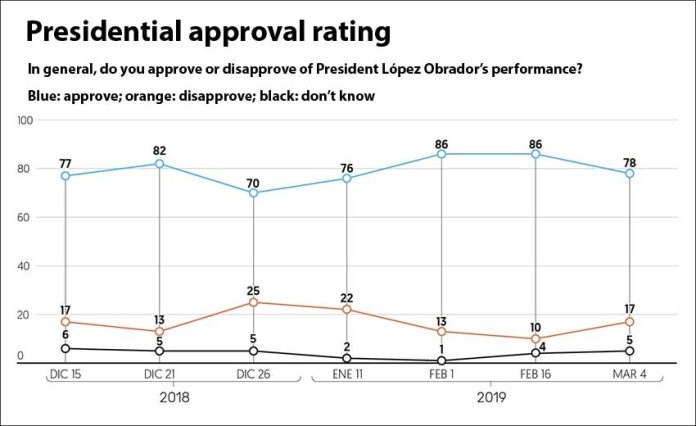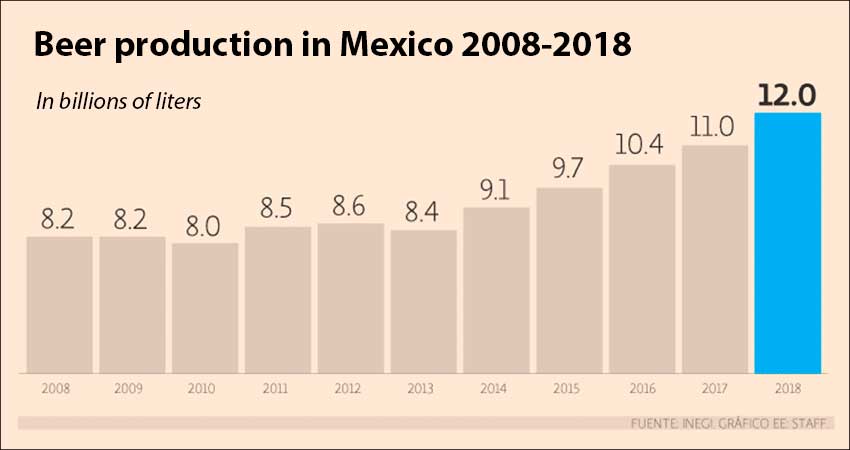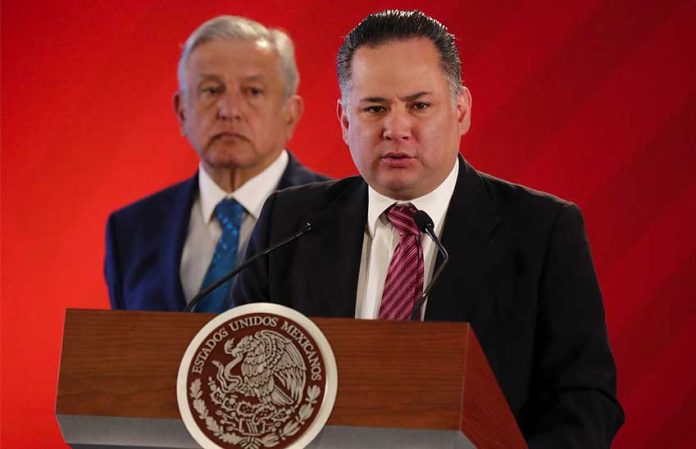President López Obrador declared that his government is “doing very well” and pledged to put his rule to a vote midway through his six-year term after a new poll showed that he has an approval rating of 78%.
“A poll appeared in the newspaper El Financiero [which shows] we have the support, the backing of the people. That’s very important because we want there to be democracy and that means a government of the people, for the people and with the people . . .” the president said yesterday.
The poll, published a week before the federal government completes its first 100 days in office, also shows that 82% of respondents would support the continuation of López Obrador’s presidency if given the opportunity to revoke his rule.
AMLO, as the president is widely known, said yesterday that a proposal to that end has already been submitted to Congress for consideration.
“Yes, I’m going to subject myself to a revocation of mandate [vote]. If the law isn’t approved, we’ll see how we can do it respectfully and without impinging on the legal framework . . . the consultation is going ahead,” López Obrador said.
The political veteran, who won last year’s presidential election convincingly on his third attempt, explained that his intention is to hold the referendum on his presidency the same day as midterm elections in 2021 in order to avoid costs associated with holding it separately.
“Let there be a ballot asking no more than: ‘Do you want the president to continue or to resign’ . . . because it [should be] the people who install [the president] and the people who remove [the president],” López Obrador said.
He added that a vote on his presidency will ensure that the government doesn’t stop working or think that it is “untouchable.”
López Obrador’s 78% approval rating among 1,000 people surveyed by El Financiero in all 32 federal entities is higher than that achieved by any of his five predecessors at the start of their term.
Vicente Fox, in office between 2000 and 2006, is the only other president in the last 30 years whose approval rating didn’t languish in the 50s in the first months after being sworn in.
However, with 70% support, he was still some way off reaching the level of popularity currently enjoyed by AMLO.
The only president in the last 30 years who reached a higher approval rating than López Obrador’s current 78% was Carlos Salinas, whose popularity hit 80% in the middle of his 1988-1994 term.
Of those who approve of the president’s performance to date, 52% of respondents said their assessment was based on what López Obrador has already done while 47% said that their evaluation was made in consideration of what they expected him to do.
Respect for freedom of speech and transparency and accountability were the most favorably viewed aspects of the government’s performance, with 66% and 59% respectively saying that the López Obrador administration fared very well or well in the areas.
The approach to fighting crime and insecurity along with the initiative to combat corruption were the next most popular aspects, both garnering 58% support, followed by management of the economy, with 53% support.
Programs to reduce poverty were viewed positively by 51% of respondents and 45% approved of the government’s foreign policies.
Asked separately about “government actions,” 79% of respondents said that they supported the move to reduce the salaries of government officials, 73% approved of López Obrador’s daily press conferences and 64% backed the creation of the national guard.
However, just 27% said that they supported the government decision to cut the funding of daycare centers.
The government’s crackdown on fuel theft was seen as the government’s most successful initiative, with 80% of respondents saying that it was very or somewhat effective.
Just under 60% of respondents said the government has had a lot or some success in its endeavor to sell the presidential plane, while 55% and 50% respectively said that its efforts to reveal the personal assets of public officials and its plan to build the Maya Train project have been successful.
Only 43% and 29% of respondents respectively considered that the government has had success in its plan to convert the Santa Lucía Air Force Base for commercial aviation use and in its investigation into the helicopter crash that killed the governor of Puebla and her husband on Christmas Eve.
Poll respondents were also asked to rate the president’s performance using baseball terminology in recognition of the fact that the sport is López Obrador’s favorite.
Just over a third of those polled – 35% – said that the leftist leader’s performance during the month of January was equivalent to a home run while 33% more said that he had scored a hit.
One in 10 respondents said that López Obrador had struck out and 9% likened his performance to hitting a foul.
Source: El Financiero (sp)












